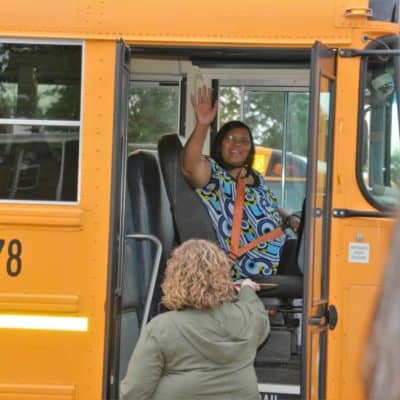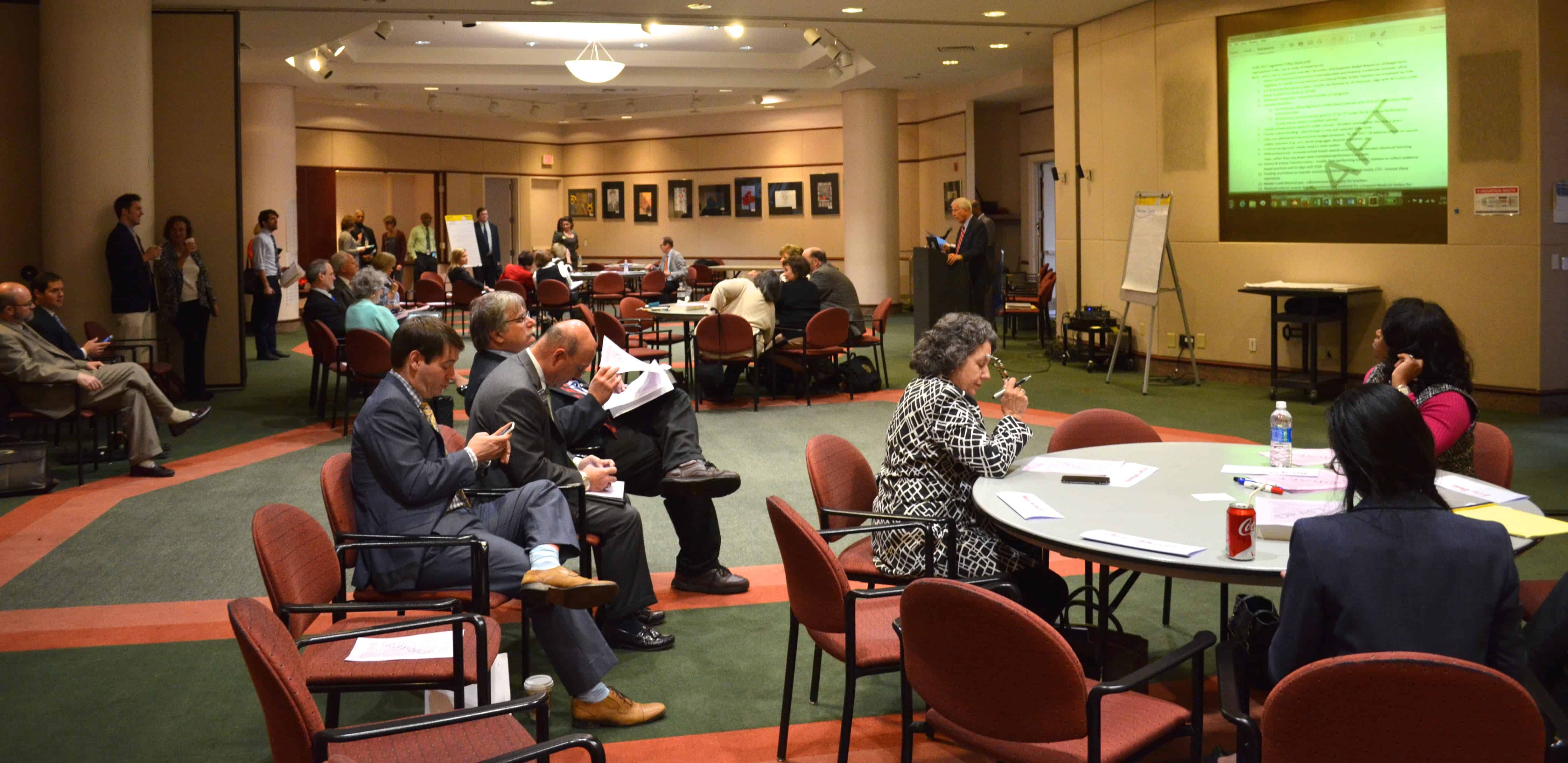Last week was a busy one for the State Board of Education, with members tackling everything from legislative priorities, requests from a slew of public schools seeking charter-like flexibility, and a farewell to long-time Superintendent of Public Instruction June Atkinson.
Legislative Priorities
The state board has already identified expansion budget-related needs that would have to be addressed by the General Assembly.
Board Chair Bill Cobey and Atkinson sent a letter to Andrew Heath, the state’s budget director, last month, laying out two different visions of their requested expansion budget.
The expansion budget includes items that are above and beyond the typical public school funding that the state usually gives.
The Office of State Budget and Management had sent out an order to all state departments, limiting expansion requests to 2 percent of agency state funding.
So, the letter sent from Atkinson and Cobey included an expansion request that met that goal, but also included expansion requests that the state board says are needed to fully fund expansion needs.
Under the 2 percent cap, the state board would be requesting $173 million.
Under the request that more fully funds public school expansion needs, the state board is asking for $534.6 million.
You can read Cobey and Atkinson’s letter to Heath here.
During last week’s meeting, the state board held a brainstorming work session to talk about other legislative priorities that don’t necessarily have budget implications.
Groups sat at different tables to whittle down a list of 21 draft legislative priorities into a more manageable number. In some cases, the groups added additional legislative priorities. At the end, the groups all announced their top priorities to the group. Using the information gathered from this meeting, the state board will identify which legislative priorities it will actually endorse.
State board member Becky Taylor, speaking for her group, identified priorities like changing the A-F schools grading system.
“We’re hearing it from the superintendents, we’re hearing it from parents, we’re hearing it from our teachers,” she said. “We know it causes a certain perception from our parents and that’s not a good thing because when a parent has a certain perception, the kid picks up on it as well.”
She also mentioned the need for the grading system to align with the new federal Every Student Succeeds Act (ESSA). Requirements under ESSA may mean the grading system would need to be reformed by the General Assembly.
State board member Amy White, speaking for another group, also listed a number of priorities, including the A-F grading system, and school calendar flexibility.
The flexibility to make their own decisions on when the school year starts and ends has been something for which districts around the state have been fighting for many legislative sessions. A bipartisan group of organizations even got together in 2015 to press for flexibility. Presently, the state mandates the public school calendar for all districts.
“We need to give control of calendar flexibility to the LEAs,” White said.
After the three working groups had all presented, their respective priorities were tallied to highlight where there were points of commonality.
All three groups supported the following priorities:
A-F School Performance Grades: modify the formula to, at minimum, align with NC’s plan under Every Student Succeeds Act (ESSA)
Calendar flexibility:
-
At minimum, allow alignment of the school calendar with that of community colleges and universities
-
At minimum, permit schools given a “D” or “F” under the A-F School Performance Grades law to adopt a modified calendar
Medicaid reform: ensure that NC maximizes the potential for untapped Medicaid dollars for eligible public school services
Pre-K & Early Childhood Education:
- Transfer Pre-K to SBE/DPI
- Increase Pre-K slots so that more at-risk children are served
Restart Schools
The state board gave approval for 19 schools — 10 alone in Wake County — to adopt the restart model, which gives them charter-like flexibility.
The approval is contingent on a financial analysis of the 19 proposals by DPI, but assuming everything is in order, the schools will be able to go ahead with their transition.
Schools that are low performing for two out of the last three consecutive years can apply for one of four innovative school reform models, including restart, though the restart model is the one that schools seem to be clamoring for.
The four models as defined in state statute 115C-105.37B are:
“(1) Transformation model, which would address the following four specific areas critical to transforming a continually low-performing school:
a. Developing and increasing teacher and school leader effectiveness.
b. Comprehensive instructional reform strategies.
c. Increasing learning time and creating community-oriented schools.
d. Providing operational flexibility and sustained support.
“(2) Restart model, in which the State Board of Education would authorize the local board of education to operate the school with the same exemptions from statutes and rules as a charter school authorized under Article 14A of this Chapter, or under the management of an educational management organization that has been selected through a rigorous review process. A school operated under this subdivision remains under the control of the local board of education, and employees assigned to the school are employees of the local school administrative unit with the protections provided by Part 3 of Article 22 of this Chapter.
“(3) Turnaround model, which would involve, among other actions, replacing the principal, if the principal has been in that position for at least three years, and rehiring no more than fifty percent (50%) of the school’s staff, adopting a new governance structure at the school consistent with this Article, and implementing an instructional program aligned with the Standard Course of Study.
“(4) School closure model, in which a local school administrative unit would close the school consistent with G.S. 115C-72 and enroll the students who attended the school in other, higher-achieving schools in the local school administrative unit consistent with Article 25 of this Chapter.”
All of these models have existed in state statute for some time. They were part of the turnaround effort under Race to the Top — those schools targeted for turnaround during that period had to use one of the reform models if they were receiving Race to the Top funds from the state.
Even after Race to the Top ended, the models still existed, but few education leaders knew they could still use them. Then last December, the Alamance-Burlington School system asked to use the restart model, setting off a process that has led to a slew of school systems following suit.
The schools approved for the restart model last week were:
Wake County Public Schools
Bugg Elementary School
Carroll Magnet Middle School
East Garner Elementary School
East Garner Magnet Middle School
East Millbrook Middle School
East Wake Middle School
Fox Road Magnet Elementary School
Millbrook Elementary School
Poe GT/AIG Basics Magnet Elementary School
Wendell Middle School
Cabarrus County Schools
Royal Oaks Elementary School
Winecoff Elementary School
W. M. Irving Elementary School
Concord Middle School
Rocky River Elementary School
Warren County Schools
Mariam Boyd Elementary School
Warren County Middle School
Northside K-8 School
Warren County High School
Virtual Charter Schools
A report on North Carolina’s two Virtual Charter Schools (not affiliated with the state’s Virtual Public School) came before the State Board of Education and received more public discussion than it previously did at the state’s last Charter School Advisory Board meeting.
The advisory board heard a report last month that showed that Pearson’s NC Connections Academy and K12, Inc.’s NC Virtual Academy, have withdrawal rates, of 31 percent (NC Connections) and 25 percent (NC Virtual) for the 2015-16 school year.
The state mandated limit for withdrawal from the schools is to stay below 25 percent, putting one of the schools right at the tipping point and the other one well over.
In addition, both schools received a “D” on the school performance grade scale for the 2015-16 school year and were labeled as low performing.
School board member Becky Taylor said the Board has to keep an eye on the schools.
“I really think we need to monitor this closely. And again it was their first year and anytime you start something brand new you’re going to have some bumps in the road. But the last thing we want to do is be in the newspaper like some of other states who have done this because we said when we did this virtual pilot that we wanted to do it right and have good articles at the end,” she said. “So I think we need to be on our toes and keep an eye on this and bring up things that may need to change along the way, because it is a pilot.”
State board Chair Bill Cobey said in an interview with EducationNC reporter Liz Bell last month that he is more worried about what happens going forward.
“I’m actually more concerned about the second year because the first year a lot of people — including a lot of homeschoolers — tend to opt in to the virtual charter school, not realizing how structured the virtual charter school is,” Cobey said. “So it’s not exactly what they thought it would be, so they tend to drop out. And I think that phenomenon — you’re over it in the first year.”
Farewell to June Atkinson
Last Thursday’s meeting of the State Board of Education was the final meeting for Superintendent June Atkinson, having lost in the most recent election to Republican Mark Johnson.
Among her closing comments, she exhorted the Board to continue to work hard for educators and against legislators who seek to add laws telling schools how they should operate.
“Please continue to push for higher education salaries and professional development dollars. Continue to elevate the profession and speak up when those unknowingly and knowingly disparage the educational profession. No entity has ever succeeded by slamming its work force. Work against the trend of adding more state laws telling schools what to do, how to do it, and when to do the work. That’s your job as state board members.”
Read a more expansive list of her comments in our Monday article, here.
Recommended reading




